.
3.11.2016

The Long March-5, China’s biggest ever carrier rocket, is now awaiting its maiden mission on the country’s southern island Hainan Province. It can carry up to 25 tons — that’s around the same weight as 16 cars — to low earth orbit. It’s 57 meters tall, and weighs about 800 tons itself.
"The Long March-Five is comparable to its international counterparts, including in the domains of booster engines, payload levels in low and high earth orbit," Yan Zheng, power system engineer of Long March-5, said.
Before China, only the United States and Europe had similar power systems. With a three-stage, five-meter-diameter, a dual-engine primary core, the Long March-5 is the widest among all the rockets developed by China. In fact, it is so wide, it could not be transported by the current railways system to the inland launch center.
"We call it 'Fat Five'. It goes beyond the current rail transportation limits of 3.35 meters, so it has to be transferred by sea to a coastal launch site," Hu Xudong, commander of Long March-5 Carrier Rocket Launch Mission, said.
Completed in 2014, the Wenchang Satellite Launch Center is the only launch center near China's coast. But the sheer size of Long March-5 means that it's like a new age for China's space program.
"The liquid propellant consumption of the Long March-5 is tenfold more than previous rockets. Just in the fueling process, we have to invent many new technologies and devices like the low-temperature valve of mass flow and the new liquid oxygen pump," Zhang Qing, Fueling Engineer of Long March-5, said.
Once in operation, its highest-profile mission will be launching the core module of China's permanent space station — Tiangong, as well as the lunar and Mars missions.
The space launch was a global high-profile event, but for the thousands of engineers working behind the scenes, it's years of dedication, separation from families, and loneliness in hard work. But they say, it's all worth it.



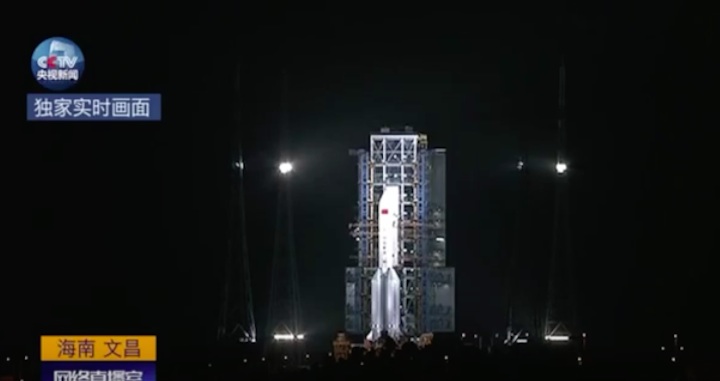
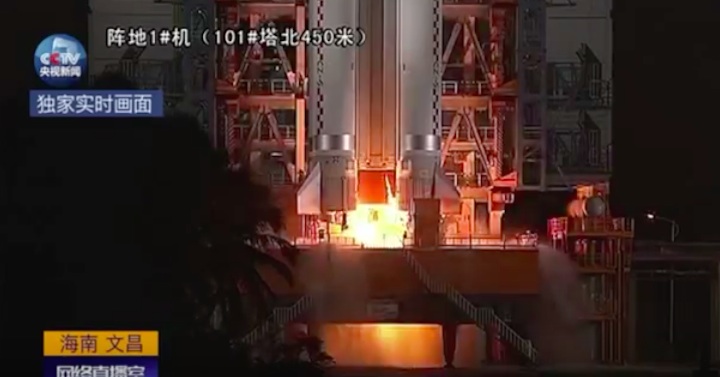
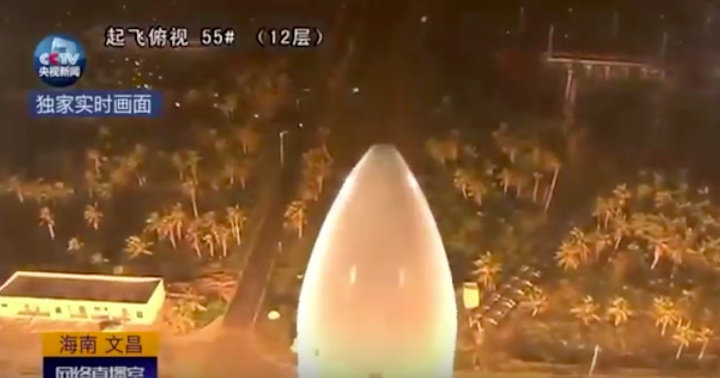

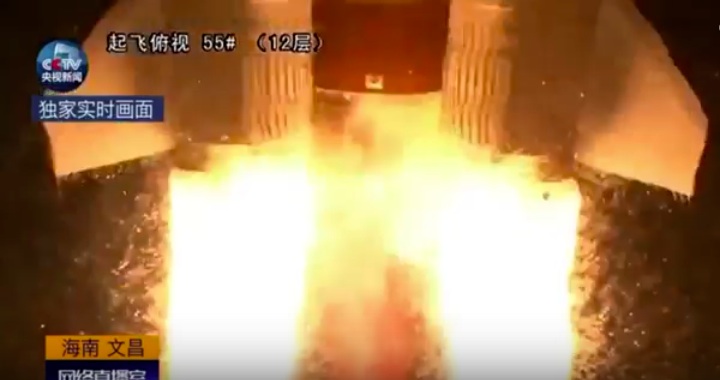


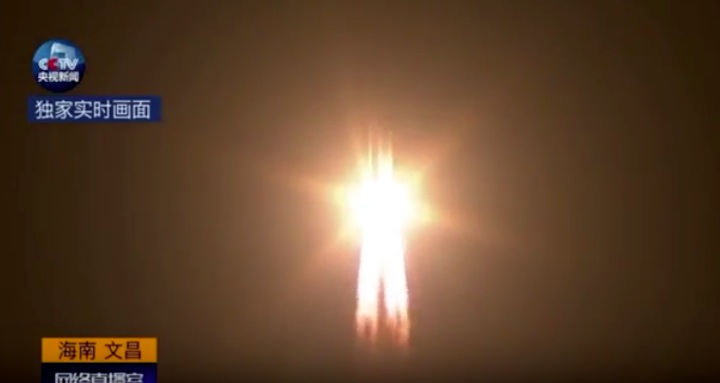
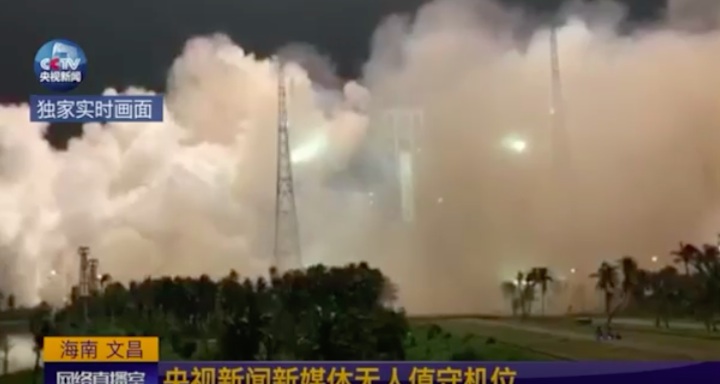

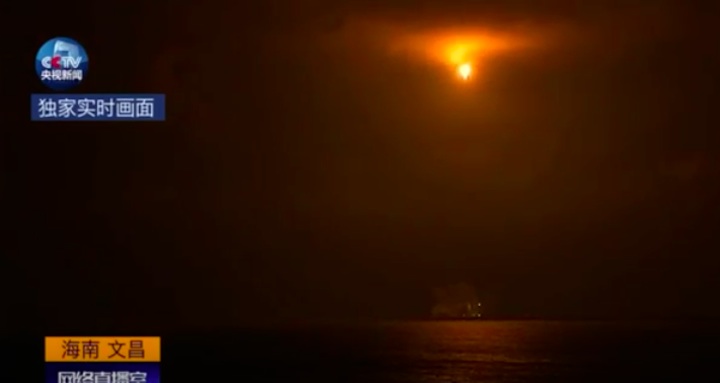











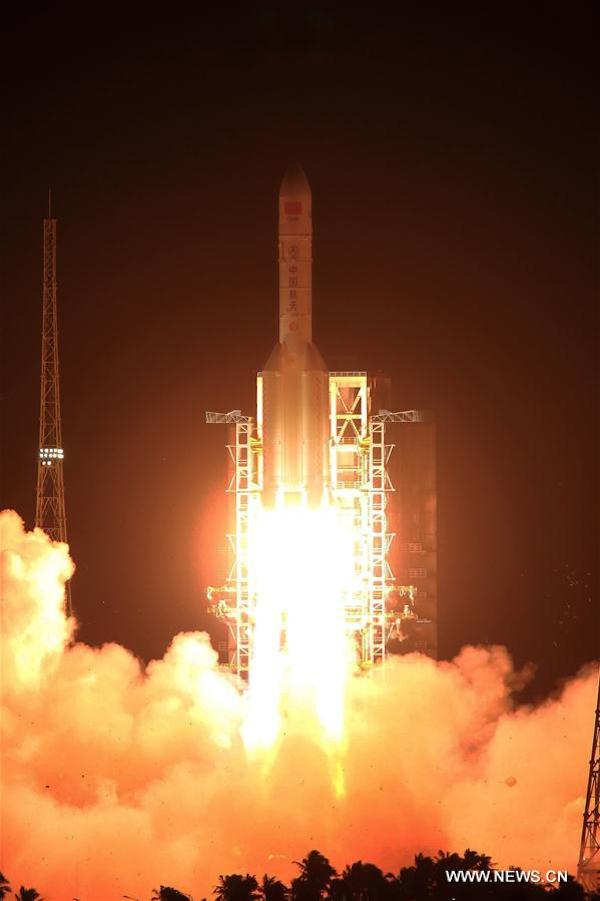

Quelle: CCTV
-
Update: 4.11.2016
.
New heavy-lift carrier rocket boosts China's space dream

The graphics shows China successfully launched its newly-developed heavy-lift carrier rocket Long March-5 from the coastal Wenchang Space Launch Center in southern Hainan Province at 8:43 p.m. on Nov. 3, 2016. (Xinhua/Meng Lijing)
WENCHANG, Hainan, China on Thursday launched its new heavy-lift carrier rocket Long March-5.
The rocket, which looked much "fatter" than other rockets of Long March series, blasted off at 8:43 p.m. Beijing Time from the Wenchang Space Launch Center in south China's Hainan Province. The payload was sent into the preset orbit about 30 minutes later.
The State Administration of Science, Technology and Industry for National Defence (SASTIND) later announced the complete success of the launch.
The launch was delayed for less than two hours from the previously scheduled time. Tian Yulong, chief engineer of the SASTIND, told Xinhua that as it was the first launch of Long March-5 in a new launch site, many parameters needed to be debugged and various systems needed to be matched with each other.
"It was normal preparation work to ensure a successful first launch," Tian said, adding that it caught up with the launch window.
The major targets of the mission are to verify the design and performance of the new rocket and test the rocket's flight program, according to China Aerospace Science and Technology Corporation (CASC), the developer of Long March-5.
A congratulatory letter sent late Thursday night by the Communist Party of China Central Committee, the State Council and the Central Military Commission hailed the new rocket as the pinnacle of innovation in carrier rocket science and technology.
Its successful launch has propelled China to the forefront of the world in terms of rocket carrying capacity, and marks a milestone in China's transition from a major player in space to a major power in space, the letter said.
The Long March-5 is a large, two-stage rocket with a payload capacity of 25 tonnes to low-Earth orbit and 14 tonnes to geostationary transfer orbit, the largest of China's carrier rockets. Its carrying capacity is about 2.5 times that of the current main model Long March carrier rockets.
According to the CASC, the rocket uses two kinds of fuel, kerosene/liquid oxygen as well as liquid hydrogen/liquid oxygen, rather than highly toxic propellant, making it more environmental friendly and less expensive.
The rocket is about 57 meters long, with a takeoff weight of 870 tonnes and a thrust of 1,060 tonnes. It is equipped with eight liquid oxygen/kerosene rocket engines in four strap-on boosters, two liquid hydrogen/liquid oxygen engines in the first stage and two relatively small liquid hydrogen/liquid oxygen engines in the second stage.
Li Dong, designer-in-chief, said the rocket was the most complicated of the Long March series with over 100,000 components instead of tens of thousands of components in other Long March rockets. Scientists conducted over 7,000 tests during its 10 years of development.
With a 5-meter diameter core stage, Long March-5 is much thicker than China's previous carrier rockets with 3.35-meter diameter core stages.
Other launch sites in China are located in inland areas. Accordingly, transportation of rockets rely on railways, so that rockets cannot be too wide.
The heavy-lift rocket launched Thursday was taken to coastal Wenchang from the northern port city of Tianjin by ship in early September.
"It is not just a simple enlargement of the diameter, it raised new requirements of materials, manufacturing and equipment," said Lou Luliang, deputy designer-in-chief.
Lou said the new technology in Long March-5 would be used in other Long March series rockets in a bid to upgrade all rockets.
The heavy-lift rocket is a milestone for China to become a real space power in the world, said Li Dong.
Experts said the Long March-5 will also lay the foundation for future rockets with heavier payload capabilities.
The new rocket is of great significance as China's space program relies on the carrying capabilities of launch vehicle systems.
With the heavy-lift carrier rocket, China can build a permanent manned space station and explore the moon and Mars.
In 2017, China will launch the Chang'e-5 probe to the moon, which will bring lunar samples back to Earth aborad the Long March-5. The 20-tonne core module of its first space station will also be delivered by the rocket in 2018.
The rocket will launch the Mars probe around 2021.
It is the second launch from the coastal Wenchang center. On June 25, China's new generation medium-sized Long March-7 made its debut at the site.
On Sept. 15 China sent Tiangong-2 space lab into orbit, making a step closer to the dream of building the country's permanent space station.
On Oct. 17, the Shenzhou-11 spacecraft carried two Chinese astronauts to space. Two days later it docked with Tiangong-2.
The two astronauts will spend a month in the space lab and return to Earth, making it the longest-ever manned space mission of China.
Tian Yulong said at a press conference after the launch on Thursday that China is now developing a mega rocket with the capacity of sending up to 100 tonnes of payload to low-Earth orbit.
The mega rocket will probably make its maiden flight before 2030, Tian added.

China's brand-new heavy-lift carrier rocket Long March-5 blasts off from Wenchang Space Launch center in south China's Hainan province, at 8:43 p.m. Beijing time, Nov. 3, 2016.
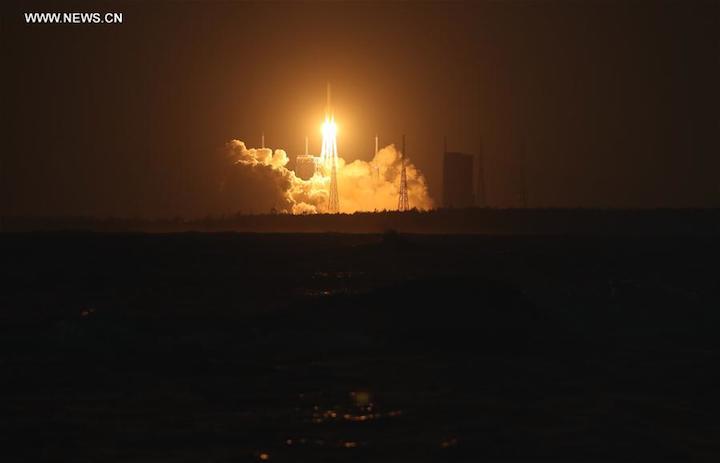

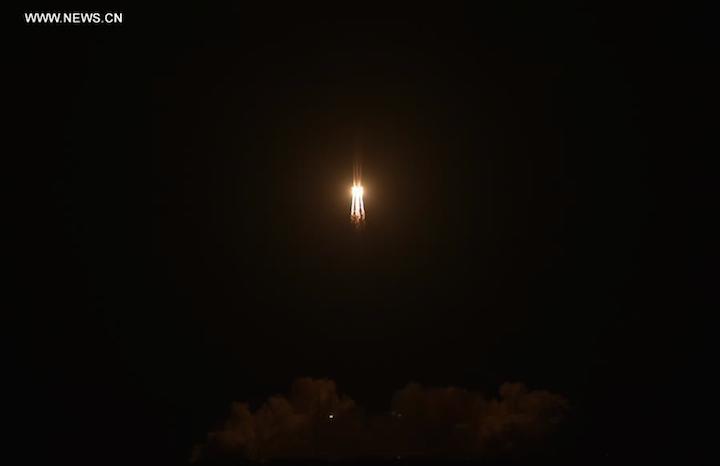

Long March-5 reflects China's "greatest advancement" in new launcher family: U.S. expert
China's launch of its first heavy-lift rocket, the Long March-5, on Thursday reflects the country's "greatest advancement" in developing a new launcher family for both its un-crewed and crewed space programs, a U.S. space expert told Xinhua.
The rocket launched from the coastal Wenchang Space Launch Center in southern Hainan Province matches the performance of a medium U.S. heavy-lift launch vehicle such as the Delta-4 Heavy, capable of delivering a payload of 25 tons to low Earth orbit, said Charles Vick, senior technical & space policy analyst with U.S. think tank globalsecurity.org.
Vick believed the Long March-5 will be used in China's missions to build its Earth-orbiting space station and will also allow the country to conduct lunar and planetary un-crewed explorations expected to follow in the next five years or so.
"Eventually once the Long March-5 has gained high reliability, it will serve several mission for the crewed lunar program efforts and may become the crew launch vehicle for the eventual crewed lunar landing programs in planning," he said. "Additionally the Long March-5 is planned for the use of China's national and commercial COMSAT programs."
The Long March-5 is part of a new generation of China launch vehicles that aims to replace the older series of the Long March family, known as Long March 2, 3 and 4.
Instead of highly toxic propellants, the new series, also consisting of Long March 6 and 7, uses kerosene and liquid oxygen, making it more environmental friendly and less expensive.
Vick said he was also impressed that this new Long March series was developed without the Russian rocket engine technology know-how and the U.S. cryogenic technology involved.
Currently, the U.S. has several heavy-lift launch vehicles that are utilized for several payload capacity categories, including Atlas-5 and Delta-4.
Meanwhile, there are four others in development: Vulcan, Falcon Heavy and New Glenn from the U.S. commercial space sector as well as the U.S. space agency NASA's Space Launch System.
Vick said many factors are driving the space access launch vehicle industries in the U.S. and China, but each nation has its own goals.
"I would not call this a space race except for the best technological option for space access to serve each country's purposes," he said.
Quelle: Xinhua
-
Update:
Global praise for China's launch of 1st heavy-lift rocket
International scholars spoke highly of China's launch on Thursday of its first heavy-lift rocket, saying it will lay the foundation for China's future launch of rockets with heavier payload capabilities.
China launched Long March-5 from the coastal Wenchang Space Launch Center in southern Hainan Province, in a bid to verify the design and performance of the new rocket and test the rocket's flight program.
With the heavy-lift carrier rocket, China can build a permanent manned space station and explore the moon and Mars.
The successful launch reflects China's "greatest advancement" in developing a new launcher family for both its un-crewed and crewed space programs, said Charles Vick, senior technical & space policy analyst with US think tank globalsecurity.org. "Eventually once the Long March-5 has gained high reliability, it will serve several mission for the crewed lunar program efforts and may become the crew launch vehicle for the eventual crewed lunar landing programs in planning," Vick told Xinhua.
Instead of highly toxic propellants, the new series, also consisting of Long March 6 and 7, uses kerosene and liquid oxygen, making it more environmental friendly and less expensive.
Vick said he was impressed that this new Long March series was developed without Russian rocket engine technology know-how and American cryogenic technology involved.
Gao Yang, director of British Surrey Technology for Autonomous Systems and Robotics (STAR) Lab, told Xinhua that the technology of the Long March-5 has proved not inferior to heavy carrier rockets developed by other nations.
She added that the stunning carrying capacity of the Long March-5 represents China's rising capabilities and competence in this aspect, noting China's progress in space technology will, to a large extent, increase its influence in future international cooperation.
British Broadcasting Corporation (BBC) reported Thursday that "the Long March-5 gives China the capability to orbit the heaviest of payloads - such as big telecoms spacecraft and sections of its future astronaut space station."
"This puts the Long March-5 in the same class as America's current most powerful rocket - the Delta-IV Heavy," BBC noted.
Alexander Zheleznyakov, a member of the Tsiolkovsky Russian Academy of Cosmonautics, told xinhua that Long March-5 will remarkably raise China's competitive edge in the international commercial launch market.
As for the rocket's technical advantage, Zheleznyakov said the notable operability within its inner systems will help facilitate its production and decrease costs, which is key to its future commercialization. China is now developing a mega rocket with the capacity of sending up to 100 tonnes of payload to low-Earth orbit. Its maiden flight will probably take place before 2030.
Quelle: Xinhua
